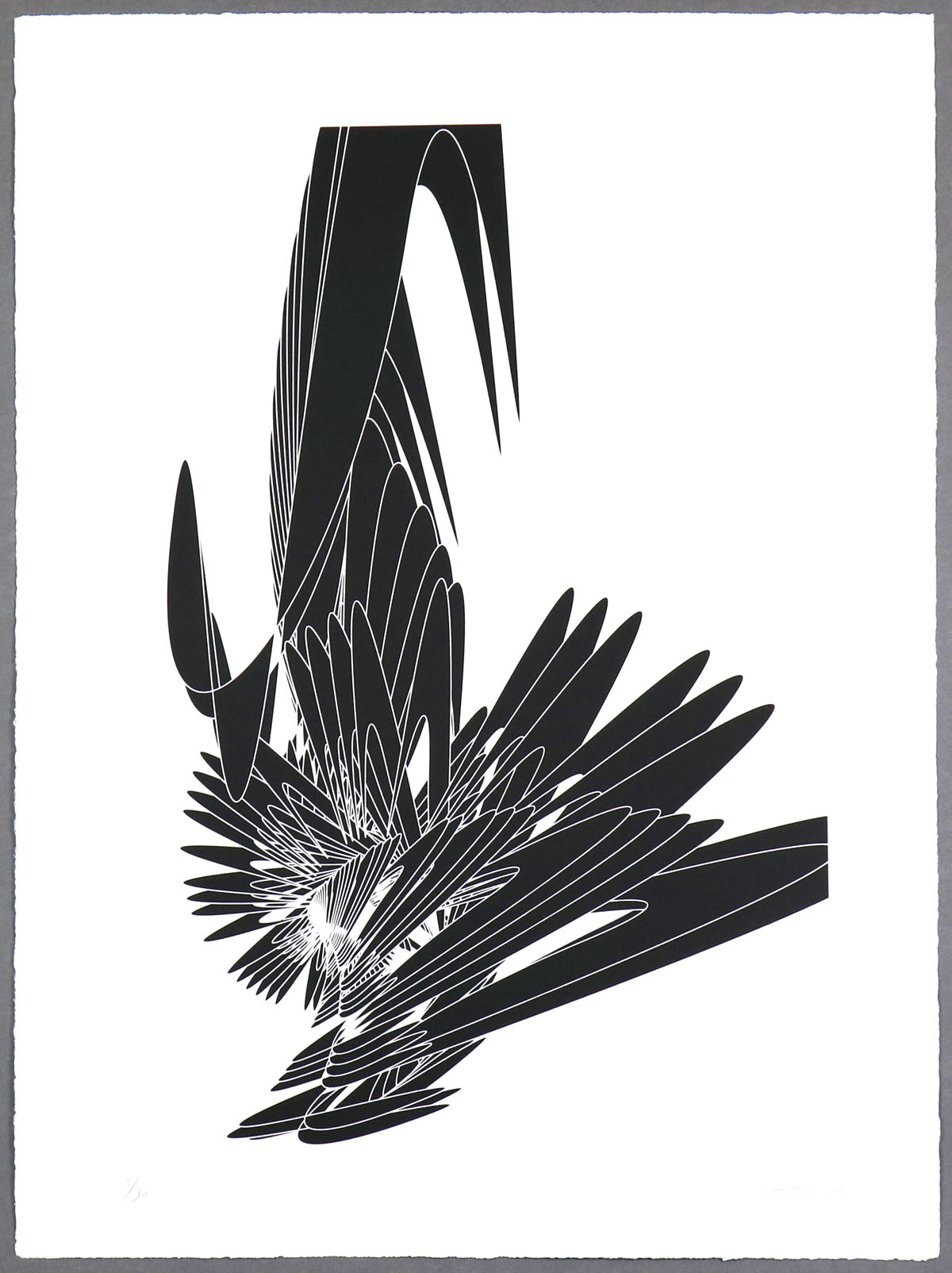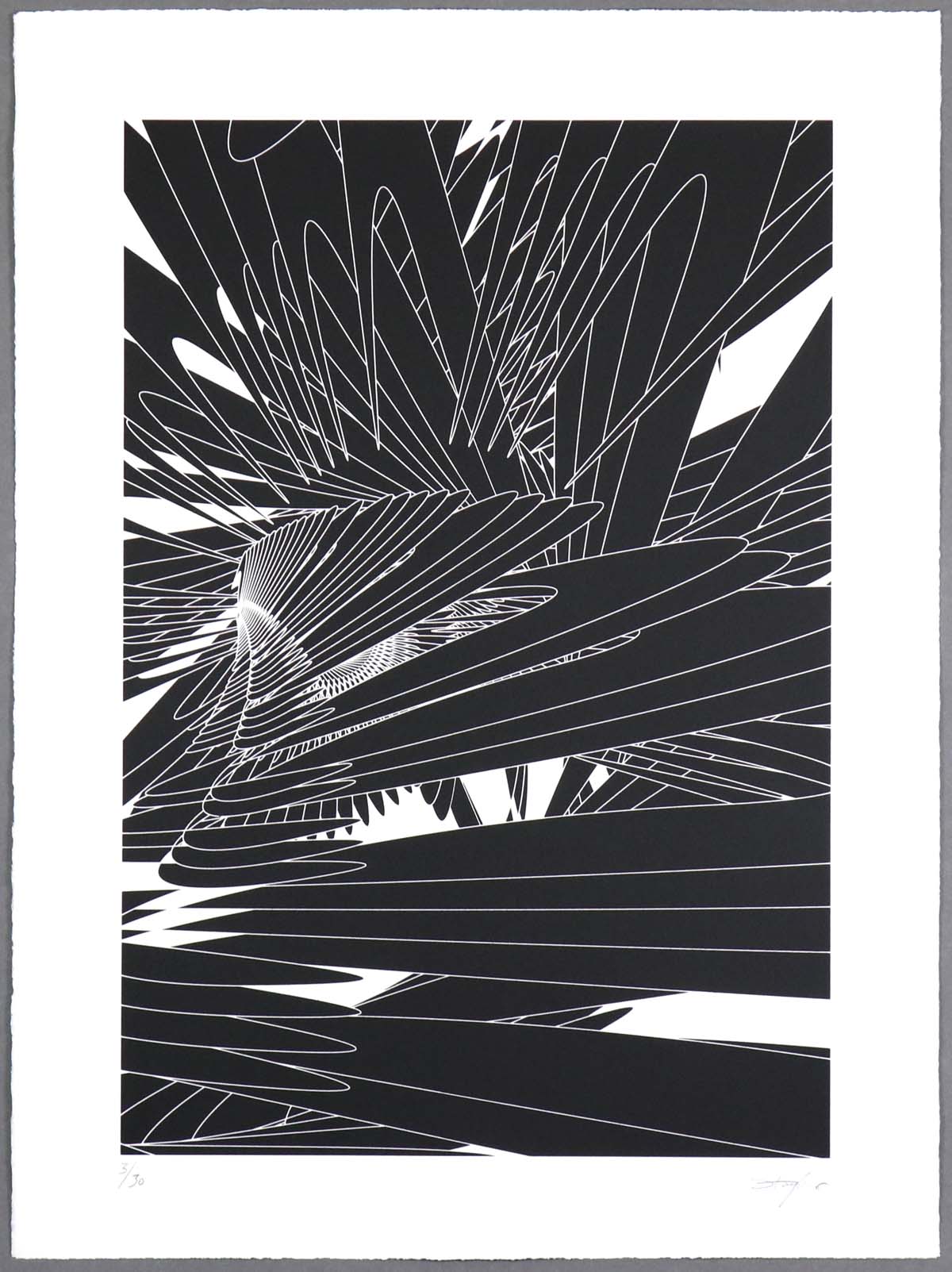A graphic experimentalist and image-maker, British artist
Simon Taylor has evolved his artistic practice for more than thirty years with the use of a broad range of cutting-edge digital technologies. In the early nineties he co-founded Tomato; an artist’s collective, bringing together poets, musicians, filmmakers and graphic designers to create a forum to cultivate and nurture ideas without imposing limitations. Taylor’s two screenprint editions,
Kinetics 1 and
Kinetics 2, are a representation of his deep-rooted ideas about graphics, rhythm, dynamics and limitlessness.
At the brink of dawn of the internet, “old-fashioned” offline technology was speeding ahead. The fax machine was high-tech, portable TV’s had 2-inch black and white screens and the cellular phone was transformed from a 3-kilo-brick to something truly mobile. German bands such as Kraftwerk and Neu! had been lurking in the underground music scene for some years, experimenting with electronic sound from synthesizers and voice-coders - and by the late eighties they had become mainstream. In Britain, the new electronic music-to-synthpop-to-dance band Underworld, founded by Karl Hyde and Rick Smith, was appearing on the charts. The common ground for bands like Kraftwerk and Underworld was the new technology and how it was embraced in every aspect of their creations; from the lyrics and sound to album covers, music videos and performances.
In London’s Soho a group of young creative people were tuned-in on the same wavelength, ready to pioneer a change from the earlier wave of British graphic designers. At best it was a chaotic pool of creation. Coming from a broad spectrum and all walks of the creative scene they were throwing in their ideas making it the rule of day that everything was a valid input and positive contribution. Piloted by Steve Baker, Dirk van Dooren, Simon Taylor, Graham Wood, John Warwicker and Karl Hyde and Rick Smith from Underworld, the easy-going gatherings were formalised into the design collective Tomato in 1991.
Tomato was not a traditional design collective. The initial idea was to bring different artistic practices under one roof and create a multi-disciplinary space for all to thrive. Graphic designers were writing lyrics; filmmakers were having a go at album covers; and musicians experimenting with sonic dynamics to create design. To Underworld, Tomato became an invaluable organisation of people, empowering them to handle various creative tasks for the band; tasks which today are quite commonplace in the music business.

SIMON TAYLOR
Kinetics 2, 2007
Edition of 30
10 Artist Proof (APs)
43(w) x 63(h) cm
16.93(w) x 24.80(h) inches

SIMON TAYLOR
Kinetics 2, 2007
Edition of 30
10 Artist Proof (APs)
43(w) x 63(h) cm
16.93(w) x 24.80(h) inches
|
|
|
43(w) x 63(h) cm
16.93(w) x 24.80(h) inches
|
Screenprint on Somerset 380 gsm paper.
Signed and numbered on front.
Edition of 30
|
|
Like the fellow founders of Tomato, Taylor was born in the swinging sixties. He began to flex his creative instincts while still at high school, messing around with cameras and video equipment. Later he studied at Bath Academy of Art and graduated with a BA (Hons) in Graphic Art from London College of Printing. In the mid-eighties he started to create paintings, videos and installations - and his ingenuity eventually led to the fashion brand UACT and the electro-music band Johnny Conquest, formed in 1999. Regardless of the kind of project that entered Taylor’s creative sphere over the years, his endeavours have progressively orbited around the art and design collective and his friends at Tomato.
Taylor’s artistic practice is founded on an early fascination to use and combine the latest technologies to create imagery. In the early days at Tomato, they would develop photo and text works by taking an image or document and insert it into the Canon fax machine. Holding back the image with their hands, creating a resistance in feeding process of the fax machine, the output would be distorted, stretching the words and rasterise the black and white image. Other processes would include the making of photograms by shooting light through jelly-cubes onto light sensitive paper - or the use of music, sound and rhythm, which was then translated into image-movements in their videos.
Kinetics 1 and
Kinetics 2 bring Taylor back to a time where he took the first steps in graphic design at London College of Printing. The striking black and white screen prints emerge from the fertile territory between art and design, a zone in which Taylor feels entirely at home. Described as kaleidoscopic images and a random chaos momentarily stilled and displayed as a vortex of swirling parabolas receding into infinity,
Kinetics 1 and
Kinetics 2 are perhaps much closer to the artist’s music. There seem to be a direct resemblance between ‘Kinetics’ and the electronic music, such as Underground and Johnny Conquest; compositions made from few synthetic notes with lyrics, repeated again and again in a basic rhythm.

SIMON TAYLOR
Kinetics 1, 2007
Edition of 30
10 Artist Proof (APs)
43(w) x 63(h) cm
16.93(w) x 24.80(h) inches

SIMON TAYLOR
Kinetics 1, 2007
Edition of 30
10 Artist Proof (APs)
43(w) x 63(h) cm
16.93(w) x 24.80(h) inches
|
|
|
43(w) x 63(h) cm
16.93(w) x 24.80(h) inches
|
Screenprint on Somerset 380 gsm paper.
Signed and numbered on front.
Edition of 30
|
|
Comparing the two works on paper with the artist’s music video for ‘Einsturzende’, there is a clear analogue connection between the music, lyrics and video - and the prints. ‘Einsturzende’, meaning ‘collapsing’ in German, is composed with an uncomplicated electronic tune - and layered by the simple and repeated lyrics:
“You will find me if you want me in the garden, unless it is pouring down with rain”. In the music video the movement of a digital metallic cube is directed by the sound beat, with the shot shifting from a single frame closeup to multi-screen frames of the same image-loop. In a similar composition,
Kinetics 1 and
Kinetics 2 are based on one visual component: a black long and rounded vectorised shape. This monochrome fluid form repeats itself endlessly, like the notes in his Taylor’s music, taking different proportions and forms, as a piece of electronic music. The final arrangement of the screenprints have a strangely organic quality, like the plumage of some fabulous cybernetic bird.
It would be inaccurate to describe Simon Taylor’s career, without considering the collective success of Tomato. Most of the work produced between them were exactly that: created through mutual ideas and brainstorming within the ranks of the artist collective. As part of Tomato, the works by Taylor have been widely exhibited in museum shows, solo exhibitions and group shows since the early nineties. Eight books have been published over the years earning the collective critical acclaim of their experimental approach to image and design.
As part of an exclusive collaboration between
Simon Taylor and Eyestorm, two print editions were released in 2007.
Kinetics 1 and
Kinetics 2 are monochrome screenprints in editions of 30 each, signed and numbered on front. The hand-torn edge of the paper is a soft contrast to the sharp visual silhouettes in the printed image itself.
Two screenprint editions on foil,
Cube and
Tetra, were released the same year in collaboration with
Jason Kedgley, who joined Tomato in ‘96.
You can find more information about the two print editions,
Kinetics 1 and
Kinetics 2, on
Simon Taylor’s artist page
here.